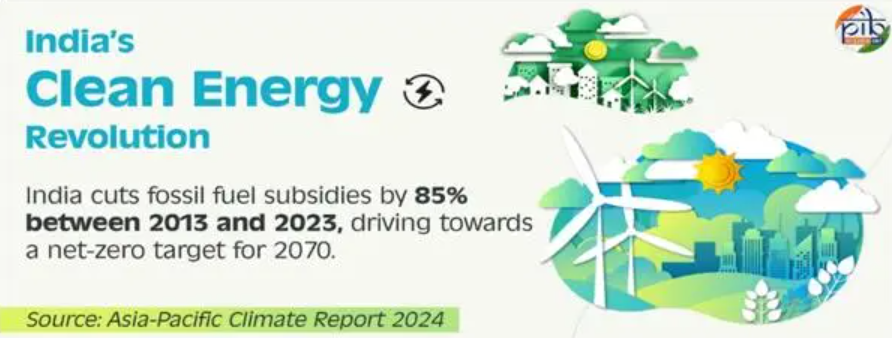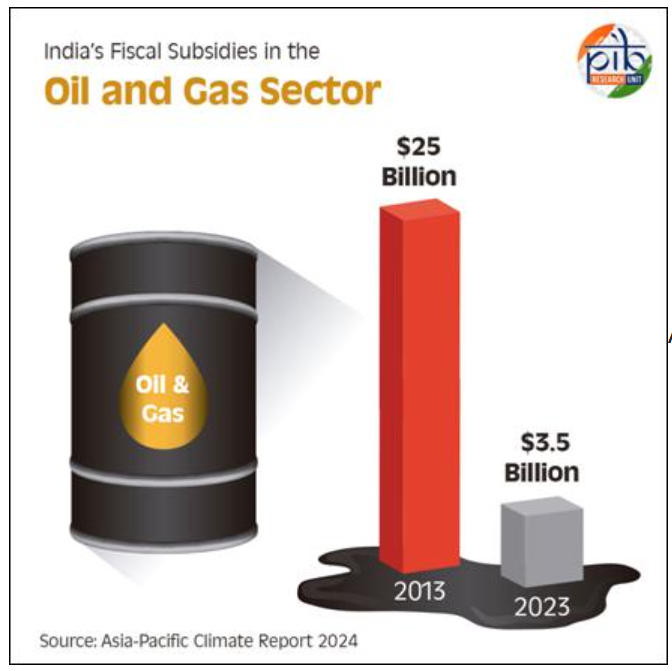India’s Green Leap: A Shift from Fossil Fuels to Clean Energy
(Source – https://pib.gov.in/PressNoteDetails.aspx?NoteId=153385&ModuleId=3®=3&lang=1 )
| Topic: GS3 – Indian Economy – Infrastructure – Energy |
| Context |
| ● India is undertaking significant reforms to transition from fossil fuels to renewable energy, aiming for net-zero emissions by 2070.
● The Asian Development Bank’s Asia-Pacific Climate Report highlights India’s successful strategies, including substantial reductions in fossil fuel subsidies and innovative taxation measures. ● These efforts underscore India’s commitment to sustainable development amidst climate challenges. |
Introduction

- India is making significant strides toward a sustainable energy future amidst a global dependence on fossil fuels.
- With a bold net-zero target set for 2070, India is reimagining its energy strategy.
- The Asian Development Bank’s Asia-Pacific Climate Report highlights India’s shift from fossil fuel subsidies to clean energy investments.
| Asia-Pacific Climate Report |
| ● The Asian Development Bank’s (ADB) Asia-Pacific Climate Report 2024 highlights the region’s vulnerability to climate change and its significant contribution to global greenhouse gas emissions.
● The report warns that climate change could reduce the region’s GDP by 17% by 2070 and up to 41% by 2100 under a high-emissions scenario. ● It emphasises the need for urgent climate action to mitigate the impacts of climate change, such as rising sea levels, extreme weather events, and heatwaves. ● The report also calls for increased investment in climate adaptation and mitigation measures, including renewable energy and energy efficiency. |
Shift from Fossil Fuels
- India has adopted a “remove, target, and shift” strategy to reduce its reliance on fossil fuels.
- This approach has led to a dramatic reduction in fossil fuel support, paving the way for investments in solar power, electric vehicles, and an enhanced energy grid.
- Between 2014 and 2018, India successfully slashed fossil fuel subsidies, demonstrating a commitment to transforming its energy landscape.
Implementation of Reforms
- The transition was not achieved overnight but through careful and strategic steps.
- The gradual phasing out of petrol and diesel subsidies occurred from 2010 to 2014, followed by tax increases on these fuels until 2017.
- These reforms were designed to create fiscal space for renewable projects, enabling substantial funding for clean energy initiatives.
Fiscal Achievements

- India reduced its fiscal subsidies in the oil and gas sector by an impressive 85%, from a peak of $25 billion in 2013 to $3.5 billion by 2023.
- The government redirected the savings from subsidy reductions into renewable energy projects and infrastructure.
- Increased excise duties on petrol and diesel during periods of low global oil prices generated additional revenue, which was used for targeted subsidies to expand access to liquefied petroleum gas (LPG) for rural communities.
Role of Taxation
- Between 2010 and 2017, the Government of India introduced a cess on coal production and imports, which played a crucial role in financing clean energy initiatives.
- Approximately 30% of the collections from this cess were allocated to a national clean energy and environment fund to support various clean energy projects and research.
- The cess significantly bolstered the budget of the Ministry of New and Renewable Energy, funding programs like the Green Energy Corridor scheme and the National Solar Mission, which reduced utility-scale solar energy costs.
Changes in Tax Structure
- The introduction of the Goods and Services Tax (GST) in 2017 altered the financial landscape for clean energy funding.
- The cess on coal was subsumed into the GST compensation cess, redirecting funds to compensate states for revenue losses linked to the new tax regime.
- This shift reflects the ongoing challenges in balancing taxation frameworks while supporting clean energy goals.
Major Government Initiatives
- India is advancing toward its sustainable energy targets with key initiatives, including:
- National Green Hydrogen Mission: Aiming to enhance hydrogen production and usage.
- PM-KUSUM Scheme: Promoting solar energy generation and supporting farmers.
- PM Surya Ghar: Muft Bijli Yojana: Providing free electricity to households to reduce fossil fuel dependency.
- These programs symbolise India’s commitment to creating a cleaner energy landscape.
Conclusion
- India’s determination to transition to a sustainable energy future is reinforced by insights from the Asia-Pacific Climate Report.
- These sustained efforts are crucial for addressing climate change challenges, driving economic growth, creating job opportunities and setting a powerful example for other nations to follow.
| PYQ: Do you think India will meet 50 percent of its energy needs from renewable energy by 2030 ? Justify your answer. How will the shift of subsidies from fossil fuels to renewables help achieve the above objective? Explain. (UPSC CSE (M) GS-3 2022) |
| Practice Question: Discuss the significance of India’s “remove, target, and shift” strategy in its energy transition efforts, particularly in relation to fossil fuel subsidy reforms and renewable energy investments. (150 Words /10 marks) |

